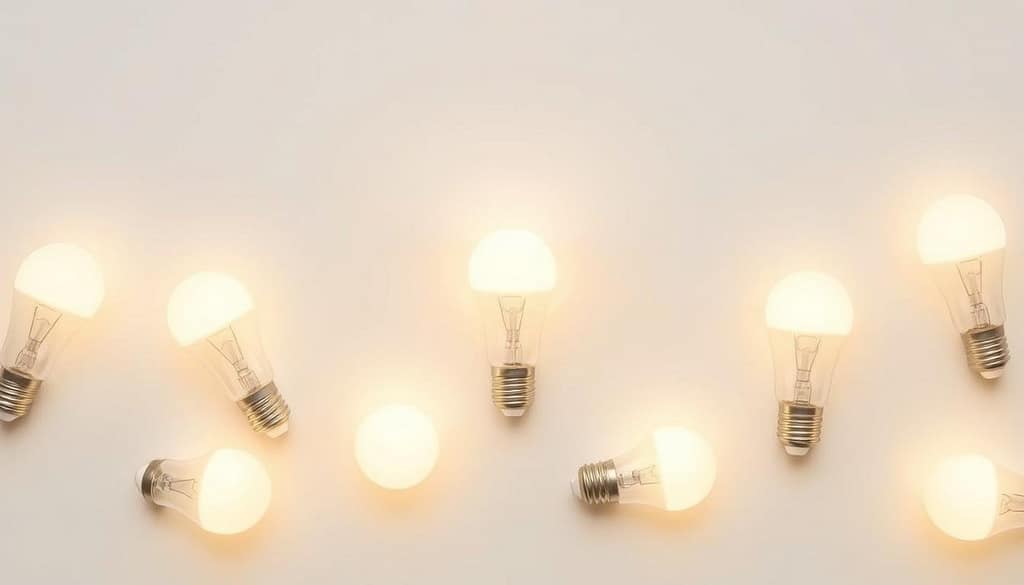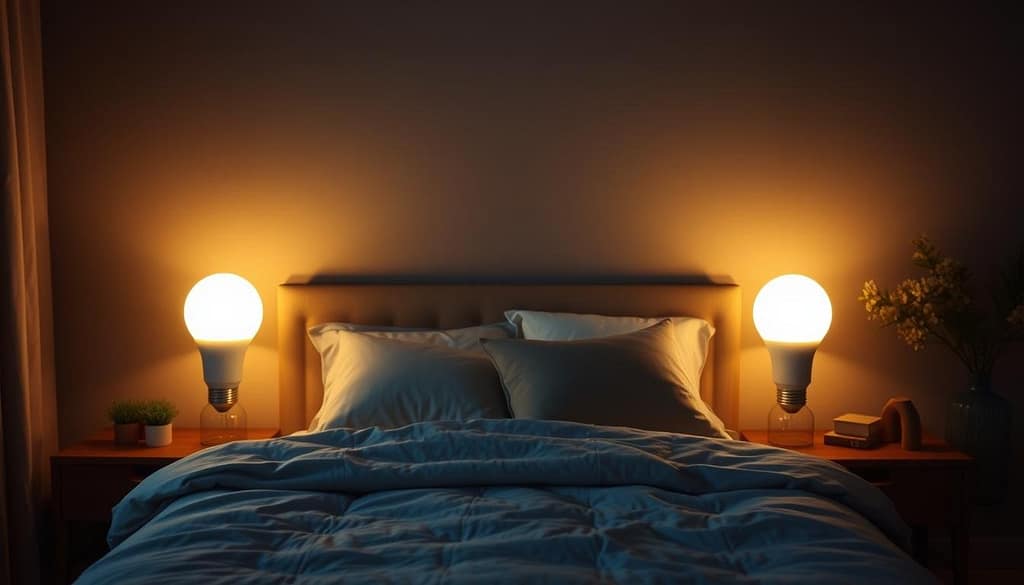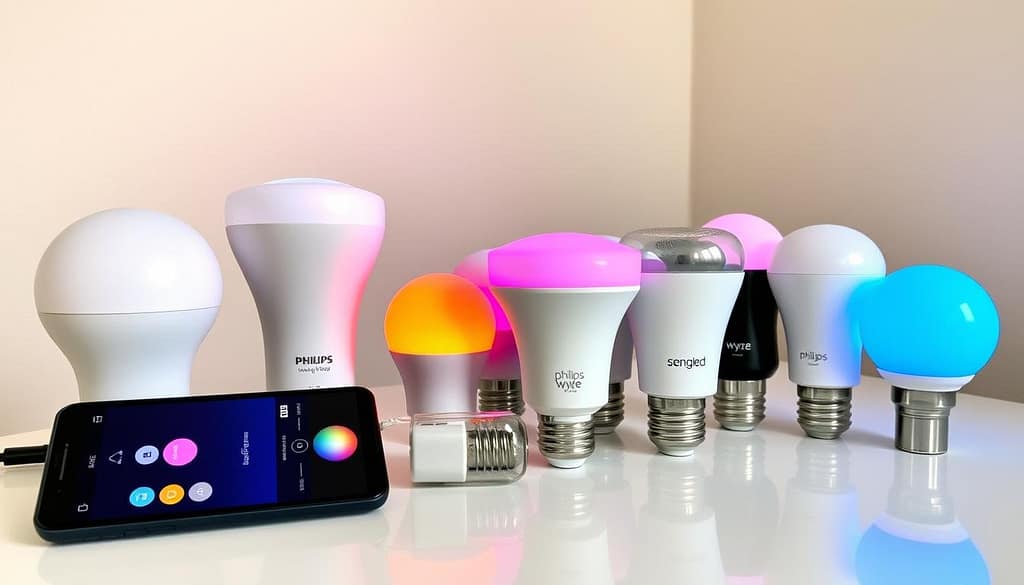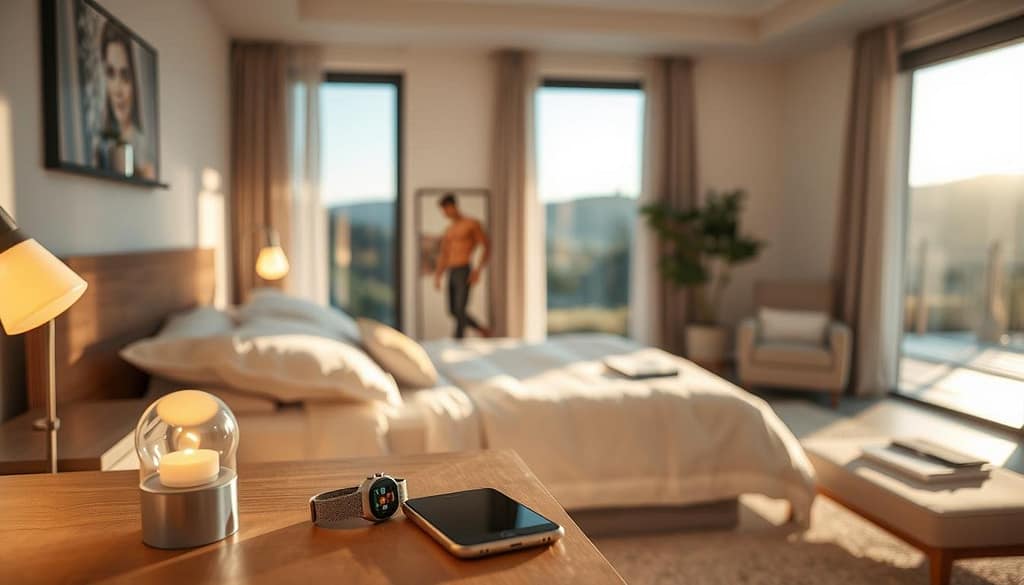When you purchase through links on our site, we may earn an affiliate commission. Here’s how it works.
Sleep is essential for our daily lives, and Smart Light Bulbs help maintain a healthy sleep schedule by creating a sleep-friendly environment that improves well-being. Our internal clock, controlled by the suprachiasmatic nucleus of the hypothalamus, is greatly affected by light cues. The University of Washington notes, “Our internal clock runs in 24-hour cycles… though it can run on its own, light cues keep us in sync with the outside world.”
Using smart home devices like Smart Light Bulbs can help create a sleep-friendly environment. This environment supports our natural circadian rhythms. It can lead to better sleep quality and overall health.
Table of Contents
- 1 The Science Behind Light and Sleep
- 2 What Are Smart Light Bulbs and Their Sleep Benefits
- 3 Types of Smart Light Bulbs for Better Sleep
- 4 Setting Up Your Smart Lighting System
- 5 Creating the Perfect Bedtime Routine with Smart Lights
- 6 Morning Wake-Up Routines Using Smart Light Bulbs
- 7 Integrating Smart Lights with Other Sleep Technology
- 8 Energy Efficiency and Cost Benefits of Smart Light Bulbs
- 9 Troubleshooting Common Smart Light Issues
- 10 Advanced Tips for Sleep-Optimized Lighting
- 11 Conclusion
Key Takeaways
- Light cues significantly influence our internal clock.
- Smart light bulbs can help improve sleep quality.
- Maintaining a healthy sleep schedule is vital for overall well-being.
- Smart home devices can support natural circadian rhythms.
- A sleep-conducive environment is key to better rest.
The Science Behind Light and Sleep
Research reveals that light impacts our sleep patterns, both positively and negatively. Grasping the science behind this connection is vital for leveraging smart lighting to enhance sleep quality.
How Light Affects Circadian Rhythms
Our bodies have an internal clock, regulated by light and darkness, known as the circadian rhythm. Light exposure synchronizes this internal clock with the external world, affecting our sleep-wake cycle. Smart lighting solutions can be set to support this natural rhythm by adjusting light intensity and color temperature throughout the day.
Blue Light vs. Warm Light: Impact on Melatonin Production
The type of light we’re exposed to in the evening greatly affects our sleep. Blue light, from standard LED bulbs and electronic devices, reduces melatonin production, the sleep-inducing hormone. On the other hand, warm light, with its lower color temperature, has a less suppressive effect on melatonin, aiding sleep.
The Melatonin Suppression Effect
Evening blue light exposure delays melatonin release, making sleep onset harder. Studies indicate that using energy-efficient bulbs with warm light in the evening can reduce this effect. This supports a more natural sleep-wake cycle. Adopting IoT lighting solutions that shift to warm tones in the evening is highly beneficial.
By understanding how different light types influence our sleep, we can optimize smart lighting for better sleep. Adjusting lighting to align with our circadian rhythms and melatonin production is a critical step towards achieving restful sleep.
What Are Smart Light Bulbs and Their Sleep Benefits
Smart light bulbs are now a key part of creating a sleep-friendly home. They do more than just light up a room; they use advanced tech to improve our sleep. This makes them a vital part of home automation.
Core Technology Behind Smart Lighting
Smart light bulbs use wireless lighting control tech. This lets us control them from our phones or with voice assistants. Features like scheduling and adjusting color temperature are essential for better sleep.
Key Features That Support Healthy Sleep
Smart light bulbs can change color temperature to mimic daylight. This circadian lighting helps our bodies keep a natural sleep-wake cycle. It boosts the quality of our sleep.
How They Differ From Regular LED Bulbs
Smart light bulbs have features that regular LED bulbs don’t. The table below shows some of these differences:
| Feature | Smart Light Bulbs | Regular LED Bulbs |
|---|---|---|
| Color Temperature Adjustment | Yes | No |
| Remote Control | Yes | No |
| Scheduling | Yes | No |
Adding home automation lighting to our daily lives can greatly enhance sleep quality. Smart light bulbs are a simple yet effective way to make our homes sleep-friendly.
Types of Smart Light Bulbs for Better Sleep
Exploring the various types of smart light bulbs is key to improving sleep quality. These innovative solutions can be customized to support a healthy sleep routine.
Color-Changing Smart Bulbs
Color-changing smart bulbs can mimic the natural light of sunrise and sunset. This helps wake users gently and signals sleep time. LED smart bulbs with color-changing features offer a flexible lighting option.
Brightness-Adjustable Options
Brightness-adjustable smart bulbs let users set the light intensity as needed. Dimming in the evening tells the body it’s time to sleep. Brighter settings boost alertness during the day.
Smart Light Strips and Ambient Lighting
Smart light strips enhance the sleep environment with ambient lighting. Placing them around the bedroom creates a calming glow that aids relaxation.
Placement Strategies for Optimal Sleep
Smart light bulb placement is critical for better sleep. Positioning them near the bed or in room corners creates a sleep-conducive space. It’s vital to avoid direct glare by considering light direction and intensity.
Understanding the various smart light bulbs and their placement helps craft a smart lighting system that aids sleep goals.
Setting Up Your Smart Lighting System
Setting up your smart lighting system is the first step towards improving your sleep quality. A well-configured system can help regulate your circadian rhythms. It also creates a sleep-conducive environment.
When you purchase through links on our site, we may earn an affiliate commission. Here’s how it works.
Choosing Compatible Hubs and Ecosystems
When selecting a smart lighting system, it’s essential to choose a hub or ecosystem that integrates well with your existing smart devices. Popular options include Philips Hue, LIFX, and Belkin Wemo. Make sure the hub you choose supports voice controlled lighting through assistants like Amazon Alexa or Google Assistant for seamless control.
Step-by-Step Installation Guide
Installing your smart light bulbs is typically straightforward. Begin by replacing your traditional bulbs with smart ones. Then, follow the manufacturer’s instructions to connect them to your chosen hub or ecosystem. Most smart bulbs can be controlled via a dedicated app, making it easy to adjust settings and monitor energy usage.
Initial Configuration for Sleep Optimization
To optimize your smart lighting for sleep, start by adjusting the color temperature and brightness. Warm white light (2700K-3000K) is generally recommended for evening use as it’s easier on the eyes and promotes melatonin production. You can also set up routines or scenes within your app to gradually dim the lights as bedtime approaches, simulating a natural sunset.
By following these steps, you can create a sleep-friendly lighting environment that enhances your overall sleep quality.
Creating the Perfect Bedtime Routine with Smart Lights
Smart lighting solutions offer a cutting-edge way to enhance your bedtime routine, promoting better sleep. By leveraging the capabilities of smart light bulbs, you can create an environment that signals to your body that it’s time to rest.
How to Program Gradual Dimming
Gradual dimming is a feature that allows your smart lights to slowly decrease in brightness over a set period, simulating a natural sunset. This can be very effective in preparing your body for sleep. To program gradual dimming, start by setting your smart light bulbs to their brightest setting at the beginning of your bedtime routine. Then, using your smart lighting app or voice assistant, schedule the lights to dim gradually over 30 minutes to an hour.
Setting Up Color Temperature Transitions
Color temperature transitions involve changing the color temperature of your smart lights from cool, energizing tones to warm, relaxing tones as bedtime approaches. This transition can help signal to your brain that it’s time to wind down. Begin by setting your smart lights to a cool white tone during the evening. As bedtime nears, transition to a warm white tone that is easier on the eyes.
Creating Automated Sleep Schedules
Automated sleep schedules allow you to set your smart lighting system to adjust automatically based on your sleep schedule. This means you can set your lights to dim and change color temperature at the same time every night, without needing to manually adjust them.
Sample Bedtime Routine Timeline
| Time | Lighting Action | Color Temperature |
|---|---|---|
| 9:00 PM | Bright Lighting | Cool White |
| 9:30 PM | Gradual Dimming | Transition to Warm White |
| 10:00 PM | Dim Lighting | Warm White |
By implementing these strategies, you can create a bedtime routine that is conducive to better sleep, using the advanced features of your smart light bulbs and IoT lighting solutions.
Morning Wake-Up Routines Using Smart Light Bulbs
Starting your day with a simulated sunrise can transform your morning. Smart light bulbs can be set to gradually brighten, mimicking a sunrise. This helps wake you up more naturally, setting a positive tone for the day.
How to Configure Sunrise Simulation
To set up a sunrise simulation, begin by adjusting your smart light bulbs to a soft glow 30 minutes before you want to wake up. Then, increase the brightness to mimic a sunrise. Most smart lighting systems let you tailor the simulation’s duration and intensity.
Programming Energizing Light Settings
Once the sunrise simulation ends, switch to an energizing light setting. This involves boosting the brightness and shifting the color to a cool white. This change can significantly boost your alertness.
Combining Light with Other Wake-Up Triggers
For a more effective wake-up, blend your smart light bulbs with other triggers like sound or vibration. Many smart alarm systems link with smart lighting, crafting a multi-sensory wake-up experience.
| Wake-Up Feature | Description | Benefits |
|---|---|---|
| Sunrise Simulation | Gradual increase in light intensity | Gentle wake-up, improved alertness |
| Energizing Light | Bright, cool white light | Increased energy, improved focus |
| Multi-Sensory Wake-Up | Combination of light, sound, and vibration | Enhanced wake-up experience, improved wakefulness |
Integrating Smart Lights with Other Sleep Technology
To maximize the benefits of smart lighting, integrating it with other sleep-related devices is essential. This creates a holistic sleep environment that boosts sleep quality. “A well-integrated sleep system can make all the difference in achieving restful sleep,” a sleep technology expert notes.
Connecting with Sleep Trackers
Connecting your smart lights with sleep trackers is a key integration. This allows your lighting to adjust automatically based on your sleep patterns. For example, lights can dim as you drift off to sleep and brighten when you wake.
Setting Up Voice Assistant Commands
Integrating with voice assistants is another vital connection. By setting voice commands, you can control your smart lights without physical interaction. This is handy when you’re in bed and don’t want to get up to adjust the lights.
Creating Sleep-Focused Automation Scenarios
Automation scenarios that link your smart lights with other sleep devices are also beneficial. For instance, you can set a “sleep mode” that dims lights, adjusts the thermostat, and locks doors. This creates a seamless sleep experience that’s both convenient and secure.
By integrating smart lights with other sleep technology, you can enhance your home automation lighting system. This is a critical aspect of using smart home devices to improve sleep quality.
Energy Efficiency and Cost Benefits of Smart Light Bulbs
Smart light bulbs are transforming our lighting habits, bringing convenience and significant energy savings. Homeowners are increasingly seeking ways to cut their energy use, and led smart bulbs are at the forefront of this trend.
Power Consumption Compared to Traditional Lighting
Smart light bulbs stand out for their energy efficiency. Unlike incandescent bulbs, which waste a lot of energy as heat, led smart bulbs are much more efficient. They convert a higher percentage of electrical energy into visible light.
Long-Term Cost Analysis
While smart light bulbs may cost more upfront than traditional bulbs, their long-term savings are significant. Here are some key points to consider:
- Longer lifespan: Smart bulbs can last up to 25,000 hours or more, compared to 1,000-2,000 hours for incandescent bulbs.
- Energy savings: By consuming less power, smart bulbs can significantly reduce your electricity bill over time.
- Reduced maintenance: With their longer lifespan, you won’t need to replace them as often, saving you money on replacement costs.
Energy-Saving Features and Settings
Modern smart lighting systems offer a range of energy-saving features, including:
- Automated dimming and brightening based on the time of day or occupancy.
- Customizable lighting schedules that can be adjusted seasonally.
- Integration with other smart home devices to optimize overall energy usage.
By adopting led smart bulbs and a smart lighting system, homeowners can enjoy both the convenience of modern lighting technology and the benefits of reduced energy consumption.
Troubleshooting Common Smart Light Issues
Mastering troubleshooting is key for those using smart light bulbs to improve sleep quality. Despite their cutting-edge features, smart lights can face problems that hinder their performance.
Fixing Connectivity Problems
Connectivity issues are a frequent problem with smart lighting systems. To fix this, make sure your smart light bulbs are close to your hub or router. Restarting your router or the bulbs can often solve connectivity problems. As Philips Hue advises, “Restarting your devices can often resolve connectivity problems.”
Resolving App and Software Challenges
App malfunctions can also affect your smart lights’ performance. Check that you’re running the latest app version and that it’s compatible with your device. If problems continue, try uninstalling and reinstalling the app.
Addressing Hardware Limitations
Hardware limitations, like the age of your smart light bulbs or compatibility with other devices, can also impact performance. Upgrading to newer models or checking for firmware updates can enhance compatibility and functionality.
By tackling these common issues, you can ensure your smart lighting system works flawlessly. This will provide the best support for your sleep.
Advanced Tips for Sleep-Optimized Lighting
Improve your sleep by using advanced lighting techniques. These strategies can make your sleep environment more conducive. This can significantly enhance your sleep quality.
Room-by-Room Lighting Strategies
Each room in your home has its own purpose. Adjust the lighting to match these functions. For example, bedrooms need a calming atmosphere, while living rooms can be brighter.
- Use warm white lighting in bedrooms to promote relaxation.
- Install dimmer switches to adjust lighting levels according to the time of day.
- Consider IoT lighting solutions that can be controlled remotely for added convenience.
Seasonal Lighting Adjustments
Our sleep patterns change with the seasons. Adjusting your lighting can help keep your sleep schedule consistent.
- In winter, use brighter lights in the morning to simulate a sunrise.
- In summer, dim the lights earlier in the evening to signal the body that it’s time to sleep.
Creating Custom Sleep-Enhancing Scenes
Custom lighting scenes can be tailored to specific activities or times of day. For example, a “reading” scene can have softer, warmer lighting. A “wake-up” scene can have brighter, cooler lighting.
Shift workers often face challenges in maintaining a healthy sleep-wake cycle. Smart lights with energy efficient bulbs can help. They create a sleep-conducive environment at unconventional hours.
- Use blue light filtering options during “daytime” to reduce disruption.
- Program your lights to simulate a sunrise or sunset according to your sleep schedule.
Conclusion
Smart lighting solutions can greatly enhance sleep quality and overall well-being. Smart light bulbs come with features like color-changing and brightness-adjustable options. They also offer automated sleep schedules to support healthy sleep patterns.
Integrating home automation lighting with other smart devices can further improve sleep. This creates a sleep-conducive environment. As a result, individuals wake up feeling refreshed and energized.
When upgrading your lighting system, consider the benefits of smart lighting for better sleep. The right smart light bulbs and a well-designed sleep routine can significantly improve sleep quality. This sets a positive tone for the day ahead.
When you purchase through links on our site, we may earn an affiliate commission. Here’s how it works.




